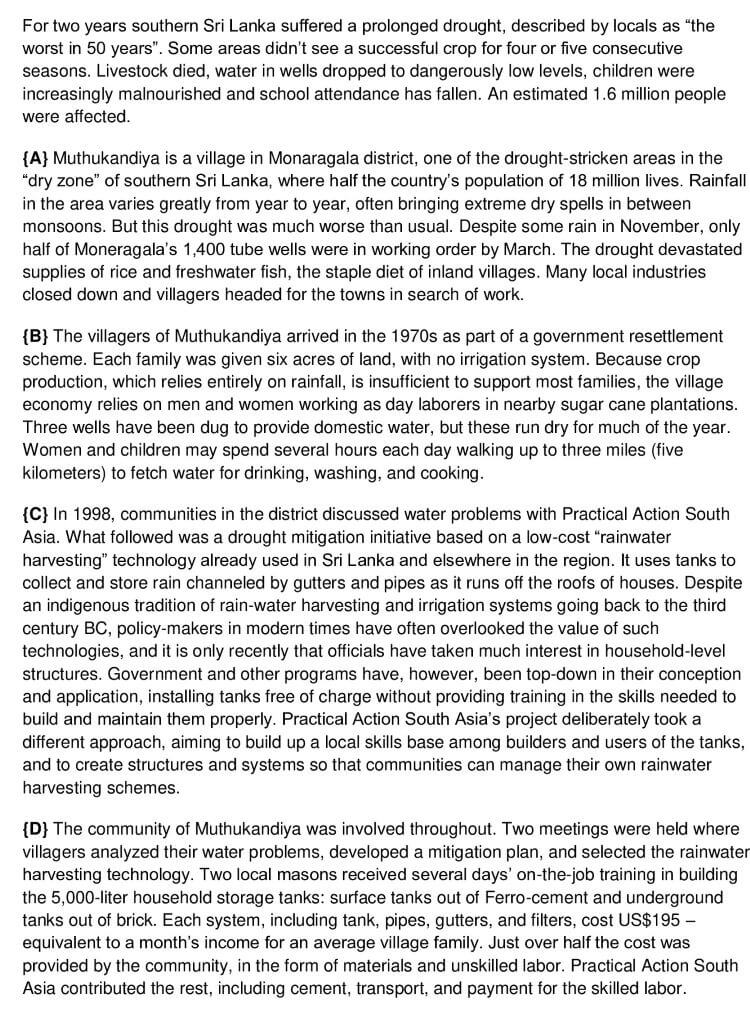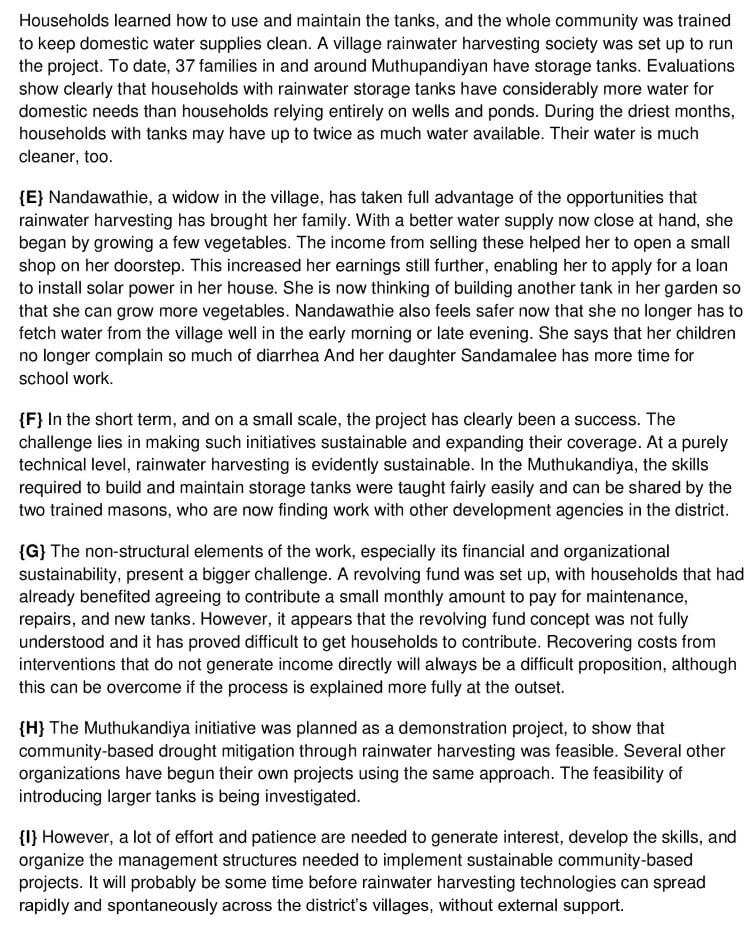Rainwater Harvesting- IELTS Reading Answers
7 min read
Updated On
-
Copy link
Table of Contents

Limited-Time Offer : Access a FREE 10-Day IELTS Study Plan!
Reading Passage
Rainwater Harvesting


Questions 1-6
Answer the questions below. Choose
NO MORE THAN THREE WORDS AND/OR A NUMBER from the passage for each answer
1 What is the major way for local people to make barely support living in Muthukandiya village?
2 Where can adult workers make extra money in the daytime?
3 What has been dug to supply water for daily household life?
4 In which year did the plan for a new project to lessen the effect of drought begin?
5 Where do the gutters and pipes collect rainwater from?
6 What helps families obtain more water for domestic needs than those relying on only wells and ponds?
Questions 7-13
| YES | if the statement agrees with the writer |
| NO | if the statement does not agree with the writer |
| NOT GIVEN | if there is no information about this in the passage |
7 Most of the government’s actions and other programs have somewhat failed.
8 Masons have trained in the construction parts of the rainwater harvesting system.
9 The cost of rainwater harvesting systems was shared by local villagers and the local government.
10 Tanks increase both the amount and quality of the water for domestic use.
11 To send her daughter to school, a widow had to work for a job in a rainwater harvesting scheme.
12 Households benefited and began to pay part of the maintenance or repairs.
13 Training two masons at the same time is much preferable to training a single one.
Reading Answers
1 Answer: Crop production
Question type: Short Answer Questions
Answer location: Paragraph B, lines 2-5
Answer explanation: “Each family was given six acres of land, with no irrigation system. Because crop production, which relies entirely on rainfall, is insufficient to support most families, the village economy relies on men and women working as day-laborers in nearby sugar-cane plantations.” These lines make it significantly clear that the villagers majorly rely upon crop production to keep up with their survival and a bare minimum sum of money.
2 Answer: Sugarcane plantations
Question type: Short Answer Questions
Answer location: Paragraph B, lines 2-5
Answer explanation: “Each family was given six acres of land, with no irrigation system. Because crop production, which relies entirely on rainfall, is insufficient to support most families, the village economy relies on men and women working as day-laborers in nearby sugar-cane plantations.” These lines suggest that since the villagers didn’t have a water supply adequate enough to carry on with the crop production sufficiently, they were left with the option of working on sugarcane plantations during the day to have an income for their living.
3 Answer: Three wells
Question type: Short Answer Questions
Answer location: Paragraph B, lines 5-6
Answer explanation: “Three wells have been dug to provide domestic water, but these run dry for much of the year.” Hence, as per these lines, three wells have been dug in order to have a water supply in the village.
4 Answer: 1998
Question type: Short Answer Questions
Answer location: Paragraph C, lines 1-4
Answer explanation: “In 1998, communities in the district discussed water problems with Practical Action South Asia. What followed was a drought mitigation initiative based on a low-cost “rainwater harvesting” technology already used in Sri Lanka and elsewhere in the region.” Hence, it was in the year 1998 when the project of alleviating the effect of draughts was first discussed and the scheme that came into the picture, as a result, was Rainwater Harvesting.
5 Answer: Roofs of houses
Question type: Short Answer Questions
Answer location: Paragraph C, lines 4-5
Answer explanation: “It uses tanks to collect and store rain channeled by gutters and pipes as it runs off the roofs of houses.” These lines explain the source from where the storage tanks store the rainwater The source is the roofs of houses.
6 Answer: Rainwater storage tanks
Question type: Short Answer Questions
Answer location: Paragraph D, lines 10-14
Answer explanation: “Evaluations show clearly that households with rainwater storage tanks have considerably more water for domestic needs than households relying entirely on wells and ponds.” Hence, the families relied more upon the rainwater harvesting tanks rather than the wells and ponds (which were the primary source of water supply prior to 1998 in the village.)
7 Answer: Not given
Question type: True/False/Not given
Answer location: N/A
Answer explanation: There is no such reference made in the passage where governmental schemes other than the Rainwater harvest have been mentioned as far as their failure or benefits are concerned.
8 Answer: Yes
Question type: True/False/Not given
Answer location: Paragraph D, lines 3-6
Answer explanation: “Two local masons received several days’ on-the-job training in building the 5,000-liter household storage tanks: surface tanks out of Ferro-cement and underground tanks out of brick.” This suggests the two masons of the village received training to create the tanks meant for rainwater harvesting.
9 Answer: No
Question type: True/False/Not given
Answer location: Paragraph E, lines 5-9
Answer explanation: “Each system, including tank, pipes, gutters, and filters, cost US$195 – equivalent to a month’s income for an average village family. Just over half the cost was provided by the community, in the form of materials and unskilled labor. Practical Action South Asia contributed the rest, including cement, transport, and payment for the skilled labor.” This makes it evident that neither the villagers nor the government paid the expenses of implementing Rainwater Harvesting and the money was rather paid by Practical Action South Asia.
10 Answer: Yes
Question type: True/False/Not given
Answer location: Paragraph D, last lines
Answer explanation: “During the driest months, households with tanks may have up to twice as much water available. Their water is much cleaner, too.” This suggests that due to rainwater harvesting tanks, the availability of water shot up to twice as much as it was before and was much cleaner and hygienic for its consumption.
11 Answer: No
Question type: True/False/Not given
Answer location: Paragraph E, lines 2-9
Answer explanation: “ With a better water supply now close at hand, she began by growing a few vegetables. The income from selling these helped her to open a small shop on her doorstep. This increased her earnings still further, enabling her to apply for a loan to install solar power in her house. She is now thinking of building another tank in her garden so that she can grow more vegetables. Nandawathie also feels safer now that she no longer has to fetch water from the village well in the early morning or late evening. She says that her children no longer complain so much of diarrhea And her daughter Sandamalee has more time for school work.” These lines suggest that the widow named Nandawathie didn’t have to work in the scheme of a rainwater harvesting establishment to keep up with her expenses or send her daughter to school. Rather she sold the vegetables which grew and thrived better due to the availability of plenteous and clean water and that’s how her daughter could go to school.
12 Answer: Yes
Question type: True/False/Not given
Answer location: Paragraph G, lines 2-4
Answer explanation: “A revolving fund was set up, with households that had already benefited agreeing to contribute a small monthly amount to pay for maintenance, repairs, and new tanks.” These lines make it quite clear that there were certain families which agreed upon paying for the reparation and maintenance of the tanks and contributing to their upkeep.
13 Answer: Not given
Question type: True/False/Not given
Answer location: N/A
Answer explanation: There is no such reference made in the passage where the benefits of training two masons have been counted corresponding to training one mason.
Check More IELTS Reading Answers
Practice IELTS Reading based on question types

Start Preparing for IELTS: Get Your 10-Day Study Plan Today!
Recent Articles

Nehasri Ravishenbagam

Haniya Yashfeen

Haniya Yashfeen

Haniya Yashfeen




Post your Comments